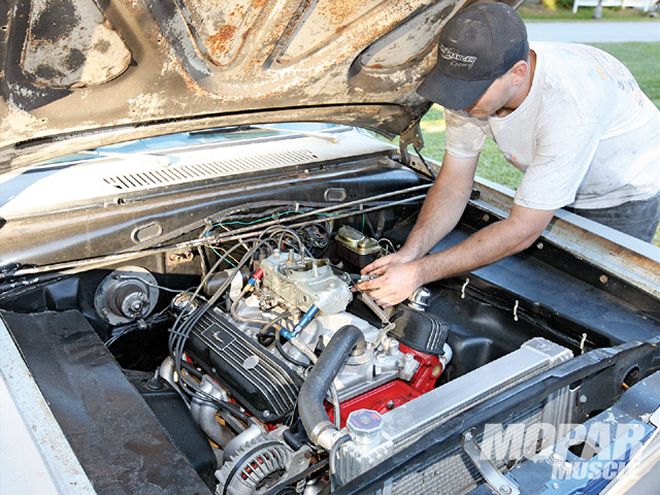
 With the engine finally together, it's time to put it in the car and find out just how it works.
With the engine finally together, it's time to put it in the car and find out just how it works.
If you've been following our budget 318 build, you know it's built and it's finally time to put it into the car-in this case, the car is a '66 Barracuda. The premise of this engine rebuild was to build a reliable engine without breaking the bank (Read: We were being cheap). We felt that we had successfully met our plan-so far. The engine was definitely put together inexpensively, but by paying attention to the new parts we used, and the condition of the used parts we re-used, we felt we should have a dependable engine when we were finished.
But, without actually putting it in something and running it, it's just a display on an engine stand-enter the "Fish." The Barracuda came from the factory with a 273 and a four-speed, and while the factory deemed this combination adequate, it's a common thought around here that a few more cubic inches couldn't hurt, now could they? Normally, we would have decided on some sort of stroker combination, but this time we decided to see just how inexpensively we could build a V-8.
Also, we've gotten so many emails over the years by guys wanting to see a 318 build, it was time. Since the Fish came with a four-speed, it also has a clutch, and in this case, we felt that the 9½-inch unit just wouldn't cut it. Sure, the 318 is not a big-powered engine, but c'mon, a 9½- inch clutch? That's like putting a 600-cfm carburetor on a 500-inch big-block-it might fit, but that don't make it right. So we bit the bullet and upgraded to a 10½-inch clutch from Ram. We decided to use Ram's HDX Clutch set. According to Ram, they are the performance upgrade for your daily driver/hot rod. Pressure plates feature increased clamp loads and their 300 Series organic clutch disc. The 300 Series consists of steel backed organic facing material that greatly increases rotational strength, and an eight-spring center hub for excellent shock absorption. It's a tight fit, but if you use the right bellhousing, it does fit and is a great upgrade.
Next we had to tackle the cooling system. The stock radiator was leaking all over the place, and was, well, old. So we contacted Flex-a-Lite and ordered one of their Flex-a-Fit radiators. The crossflow style radiator is designed with internal fins that perform as heat sinks and absorb heat more quickly from the engine coolant, then radiate it through external fins that increase the tank's radiant surface area. According to Flex-a-Lite, it's almost threefold. The unique external fin design integrates limitless fastening points into the tank itself, transforming the radiator into a convenient bracket for attaching expansion tanks, electric fans, oil coolers, etc. This new Flex-a-Fit side tank design turns an otherwise tough radiator swap into a simple installation using a few drilled brackets.
After we finally got everything fitted, and ultimately installed, it was time for a little dyno session. Before we go any further, keep in mind this is not a high horsepower thumper built to turn tires into powder. This build was very economical and done with the idea that anyone can do it-so don't snicker if you feel the power we got isn't enough. For what it is, the 318 sounds great pulling into a cruise night, and handles traffic with ease.
Before the dyno session, it took a little time to get the tuning right. Thankfully, we had access to a F.A.S.T Air/Fuel meter that made it easy. The F.A.S.T. meter uses O2 sensors that are installed into the exhaust pipe(s), read the A/F, and tell you how to jet/tune. What a great tool.
When we were happy with the results of driving around with the F.A.S.T. meter, it was finally time to strap it to the dyno. We were afraid to do any track testing yet, because the car still has a puny 7¼ rear, and we knew a couple hard launches could be catastrophic. We'll address that later. Anyway, after the big wheel quit turning, the budget 318 gave us 220 rear wheel horsepower at 4,900 rpm. That's where the power stopped climbing, so that's where we stopped. Torque came in at 260 lb/ft at 3,650 rpm. So, we built a little 318 for under $1,700 that sounds great, runs like a champ, and will spin the tires from a stop at will. It's a 318-that sounds good to us.
Parts List And CostsHeadwork$400ValvesIntake ($5.00 x 8)$40Exhaust ($4.95 x 8)$39.60Cam, lifters, springs Comp Cams